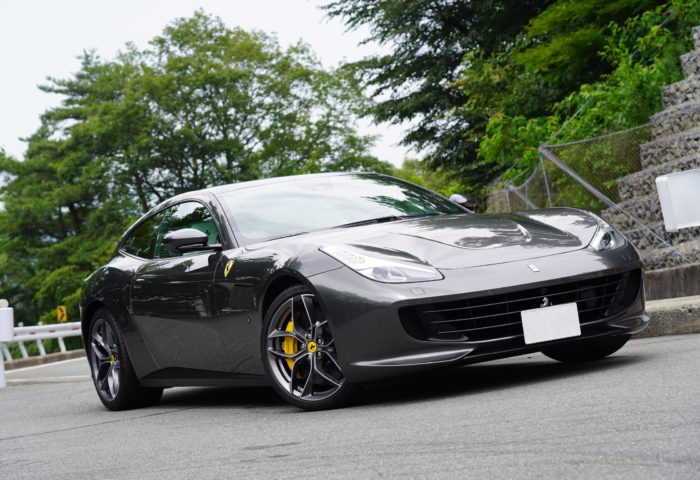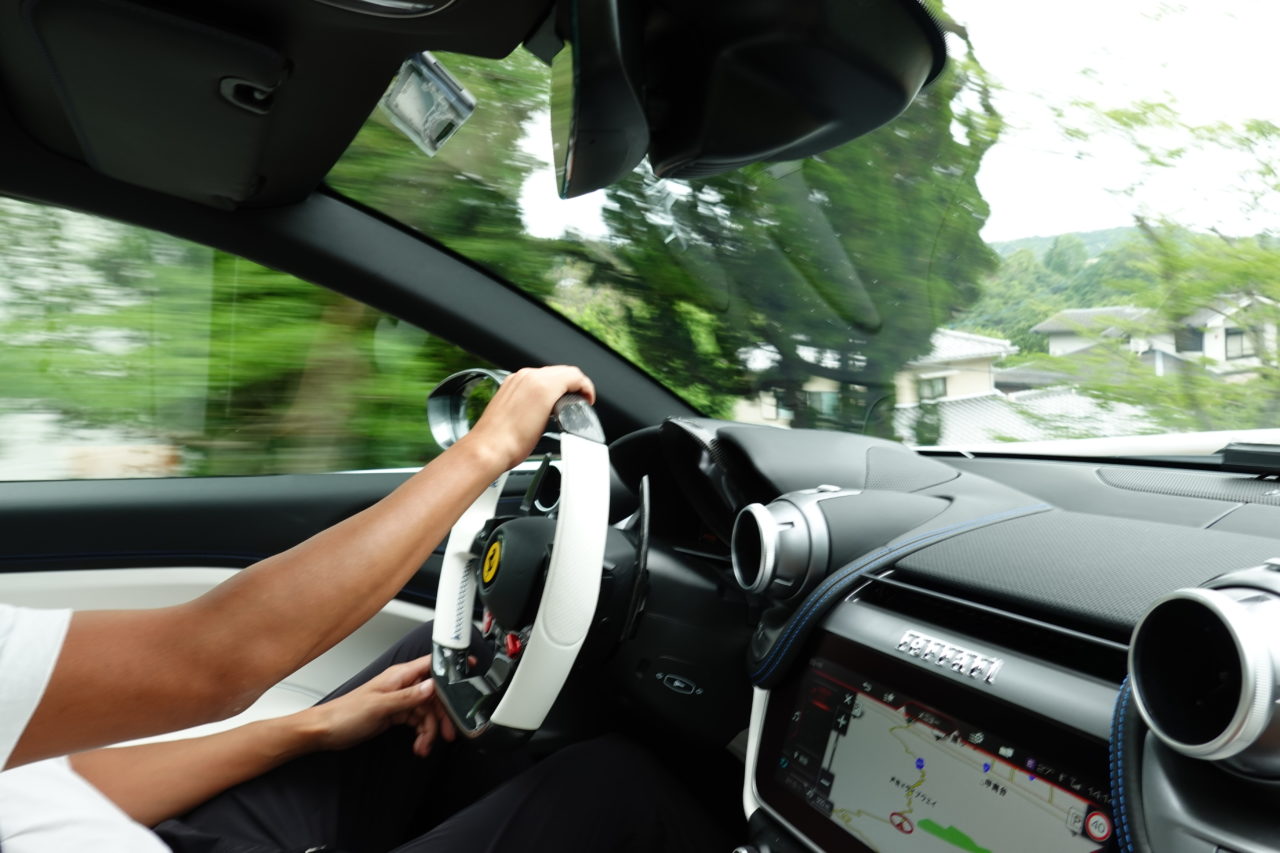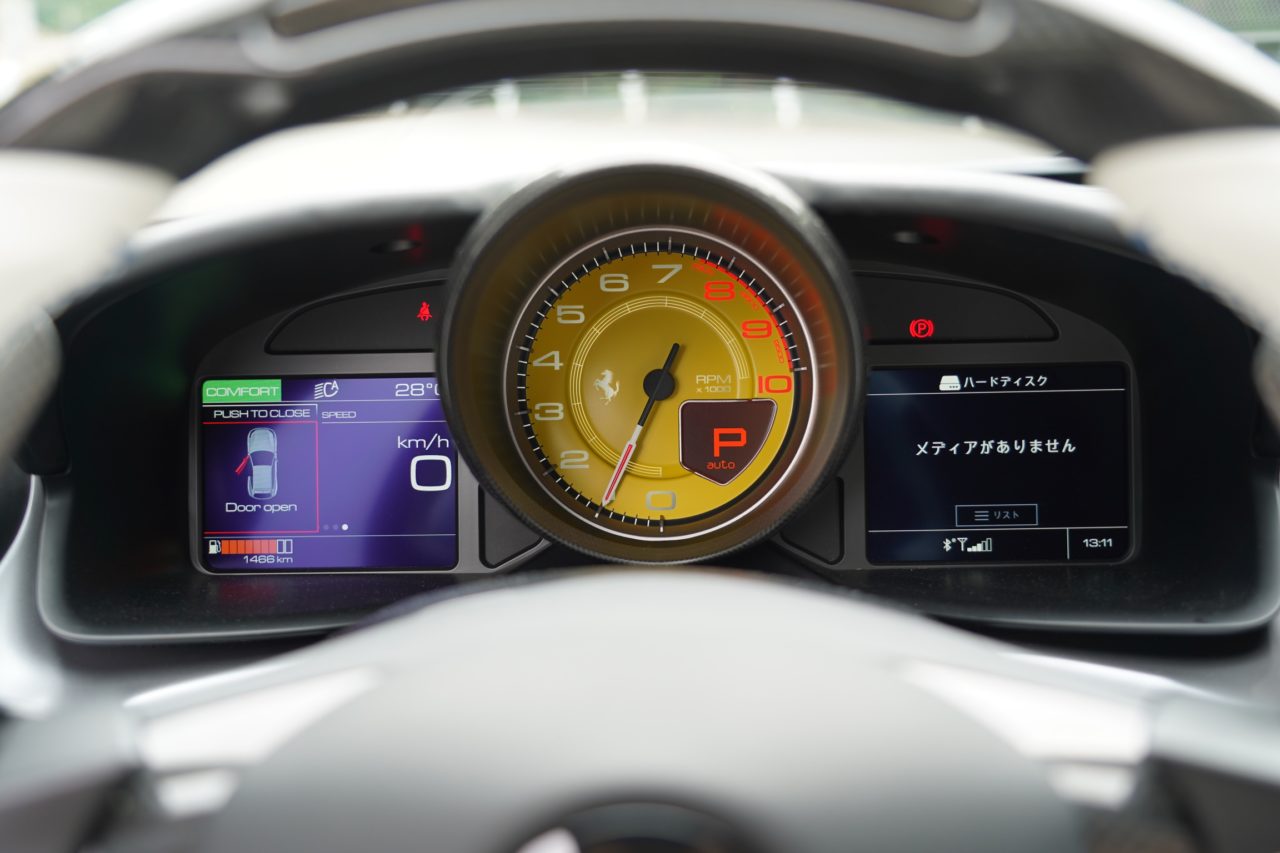My Brother’s Ferrari GTC4 Lusso T Has Arrived: A Porsche Owner’s Perspective
公開日:2020.07.01

Testing the Ferrari GTC4 Lusso T on Winding Roads
First, we headed to Royu Driveway to test the handling. The initial steering response is much tamer than what I experienced in the 488, making it more relaxing to drive even when you want to take it easy.
I haven’t confirmed, but I suspect the lock-to-lock steering angle is larger than on the 488. In Comfort mode, there is some body roll, but the car holds firm where it needs to, making it just right for sporty cruising.
At the Shakago corner, I switched to Sport mode. The GTC4 Lusso T doesn’t have a Race mode; Sport is the sportiest setting. The gears drop a notch, and the suspension stiffens, but the ride quality hardly changes. I doubt most passengers would notice the switch if they weren’t told. The difference is that subtle.
However, when approaching corners, the difference becomes clear. The amount of body roll is drastically reduced. The car corners more flatly, making it noticeably easier to drive than in Comfort mode. I’ve experienced various electronically controlled dampers, but this one’s ride quality changes very little even in Sport mode. That’s a big feature of this suspension.
The brakes are, of course, carbon-ceramic. When I drove other Ferraris like the 488, I didn’t notice this, but the GTC4 Lusso T’s brakes felt to have very little free play. It took some getting used to, and I initially felt a bit jerky in city driving. Once accustomed, it’s no problem, but the sharp bite of the carbon brakes might surprise some at first.

The 610 hp engine’s power is no joke. It’s overwhelmingly fast when revved, and the body is so strong that there’s no sense of speed or fear even at high speeds. However, unlike the 488’s V8, which feels incredibly light and revs to the redline effortlessly, this engine seems to emphasize ease of handling in low to mid-range speeds more.
In Sport mode, I tried the paddle shifters. Using the large fixed paddles behind the wheel, I shifted up from 2nd to 3rd and 4th gear. The car delivers a surprisingly strong shift shock to the driver, which is rare in modern cars. This isn’t a sign of poor automatic transmission performance, but clearly an intentional effect.
Each upshift causes a brief torque cut, then after a slight pause, the clutch engages abruptly with a roar. Passengers’ heads jerk with the G-force, making it feel like “Hey, we just shifted gears!”—a theatrical touch.
It reminded me of old-school manual cars with reinforced clutches driven by street racers, where the clutch is slammed and shifted quickly without regard for passenger comfort. This is a major difference from Porsche.
Porsche’s PDK transmissions focus on shift speed and delivering torque smoothly to the next gear without interruption, shaving off tenths of a second. The GT3’s PDK is a prime example. Ferrari, on the other hand, is an entertainer. While lap times matter, their priority is how to thrill the occupants, make them feel fast, and impress them.
Once familiar with the car, we took the hill climb from Arima side, pushing the pace a bit. Approaching the narrow, steep Royu Esses and heading toward the Royu Tunnel, when pressing the throttle a bit harder entering the tunnel, the front end showed a slight side-to-side wiggle.
It was like a horse refusing to obey, shaking its head left and right. I made small steering corrections to keep it straight.

Here, I felt what I call the “Ferrari-ness.” I’ve driven this road hundreds of times in many cars, but this kind of behavior was new. At first, it reminded me of the handling of an air-cooled Porsche RR, but it’s different. It’s more like a wild stallion’s antics—another Ferrari-style thrill ride.
My Ferrari-loving brother often says, “The slightly risky edge is part of Ferrari’s charm.” I think I caught a glimpse of that.
Calming down, I analyzed the handling more closely. The initial steering is gentler than other Ferraris, but mid-corner it sometimes suddenly bites in sharply (oversteer tendency), while at other times it seems to push wide (understeer tendency).
I tried adjusting weight transfer and steering speed, but couldn’t figure out exactly when each trait would show. One thing’s clear: the challenge of taming these quirks is where Ferrari’s true fun lies.

This is another big difference from Porsche. Porsche also offers the fun of taming an RR layout, but with Porsche, you can tame it by faithfully following driving fundamentals and learning the “correct form” in sports driving.
Ferrari, however, requires more than mastering basics. You have to understand the car’s personality and traits, and give it the right commands to truly tame it.
That depth is part of why people are drawn to Ferrari.

After spending time with the car, it became clear that even though both wear the prancing horse badge, the Ferrari from Maranello and the Porsche from Stuttgart are quite different. Ferrari and Porsche are often compared, but they aim for different goals and entertain in different ways.
I haven’t confirmed this, but I get the impression that neither manufacturer really thinks about the other. Car makers often imitate or try to get closer to competitors’ products, but these two seem to have no such intention. Both are manufacturers with a strong, unwavering philosophy.
It’s not about which is better or worse, but about what the driver seeks and aims for.
My Personal Ratings
| Handling: |  (3.5 / 5) (3.5 / 5) |
| Straight-line Stability: |  (4.8 / 5) (4.8 / 5) |
| Low-speed Comfort: |  (3.7 / 5) (3.7 / 5) |
| High-speed Comfort: |  (4.5 / 5) (4.5 / 5) |
| Engine Feel: |  (4.6 / 5) (4.6 / 5) |
| Engine Sound: |  (4.7 / 5) (4.7 / 5) |
| Brakes: |  (4.6 / 5) (4.6 / 5) |
| Transmission: |  (3.0 / 5) (3.0 / 5) |
| Average: |  (4.2 / 5) (4.2 / 5) |
このブログが気に入ったらフォローしてね!


Comment ( 0 )
Trackbacks are closed.
No comments yet.